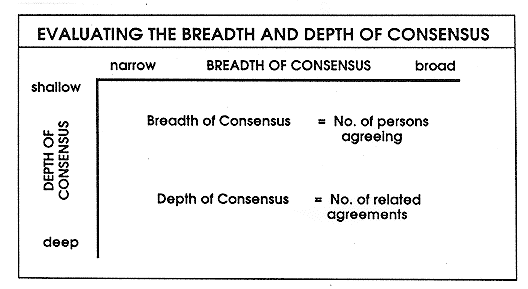
The earliest version of this article was originally published in educational Horizons Fall/Winter 1989
By Gary K. Clabaugh & Edward G. Rozycki
RETURN
edited 10/2/17
| For Google (and other) web-rankings of this article go to WebRankings. |
The More Things Change, The More They Stay the Same
There are disturbing signs that even many individuals and groups who should know better have learned little about the complexities of schools and educational improvements and are comfortable with the old bromides. Simple diagnoses and correspondingly simple solutions abound. --- John Goodlad, A Place Called School
Talk is cheap. In that realm where politics and education overlap, the currency is even more debased. Nothing is easier to declare or harder to deliver than campaign promises regarding schooling. Complex educational issues invariably generate simplistic political solutions. But slogans offer little help when practical implementation is attempted.
In what follows, we explain why it works this way. The factors our investigation deals with are expectations, consensus, tasks, and resources. Considering only these four items and how they interact, we will show that, even at the simplest level, schooling issues are politically complex.
School reforms have often been little more than fads. In the distant past, these fads received cursory attention from political candidates desperate for an issue. But for the most part, they were not the stuff of which platforms were made. Today things are different. Fads have turned into durable central issues which candidates have to address. This transformation is due to two elemental realities: the emergence of American postindustrialism and the sheer size of the schooling enterprise.
Postindustrialism in America
The United States is fast becoming a society where service industries, particularly those involving information and knowledge, surpass industrial production as the major force of the economy. This so-called "postindustrial" society is based on a global economy and international cooperation. A minority still engages in highly automated food production or the manufacture of sophisticated products unsuited for mass production in less technologically advanced societies, producing enormous surpluses in the process. But the majority provides services such as teaching, medical care, or investment banking.[1]
Knowledge, particularly technical knowledge, is the lifeblood of this postindustrial society. It is the basis for economic growth and development. From it comes new jobs, new products, and still more sophisticated services. The Presidential Commission on Excellence in Education acknowledged this when it noted:
Knowledge, learning, information, and skilled intelligence are the new raw materials of international commerce and are today spreading throughout the world as vigorously as miracle drugs, synthetic fertilizer, and blue jeans did earlier .... Learning is the indispensable investment for success in the "information age" we are entering. [2]
So the prosperity of a postindustrial society depends upon the effectiveness of its educational processes, particularly schooling. Successful competition for worldwide markets may depend on the quality of education even more than on natural resources. From an individual point of view, due to rapid change and the technical nature of job skills, lifelong education is a personal necessity. Without it one's skills soon become obsolete.
Edubusiness: revisiting the Past
Schools affect the daily lives of more Americans than any other social organization. Millions more are involved in the corporate training that has made lifelong learning an American reality. Expenditures for all types of schooling, including the training done by industry, totaled nearly half a trillion dollars in 1987. This makes formal education one of America's biggest businesses. The remarkable extent of this business is revealed in the following:
- Nearly one out of every four US citizens was in the nation's schools and colleges. In 1987, that amounted to 57.4 million people. A total of 43.7 million of those attended public elementary or secondary schools at a cost of a little over $4,000 each.
- Americans who entered the work force, in 1940 found that only 25 percent of their coworkers had completed high school. Today, as this generation reaches retirement, their grandchildren enter a work force in which 75 percent of their coworkers have graduated from high school. In 1940 less than ten percent of young adults age 20 to 24 were still in school. By 1987 this figure had jumped to 60 percent and was still climbing.
- In 1987, the total bill for all elementary and secondary public schooling came to $170 billion -- a figure identical to the gross national product of Mexico. Publicly financed colleges and universities added another $57 billion in costs, bringing the nation's 1986?87 public school bill to a total of $227 billion?all financed by taxes.
- Americans paid an additional $52.1 billion out of pocket to private schools and colleges.[3] Thus, the U.S. spent a record $278.8 billion on public and private education in 1987.[4]
- In 1986?87, 2.5 million Americans were employed as elementary and secondary school teachers. (Eighty-eight percent of them worked for the public schools.) Schools employed a total of 7.5 million people in 1986 - 87. This is more than seven percent of all the employment in the nation.
- Many other jobs are dependent upon schooling. Employment by the $1.5 billion per year textbook industry, by manufacturers of audio-visual equipment, by firms producing instructional materials, by school bus fabricators, and by many othercompanies depends largely or exclusively on schools. Many more jobs are created by the $210 billion per year corporate training industry.[5] Public health services, the military, law enforcement, and similar organizations spend billions more. When all this is considered, schooling and training add up to one of the biggest enterprises in the nation.
- U.S. expenditures on schooling as a proportion of the gross national product is exceeded by only two nations: Canada and the Netherlands.
- A family with two school-age children was receiving an average of $8,526 in school services in 1986?87. This same family spent an average $8,318 for housing, $4,773 for transportation, $4,380 for food and beverages, and $1,383 for medical care. Thus, schooling is the single largest household expense if there are two or more school?age children in the home. However, if the children attend public school, taxpayers pick up the bill.
- Increasingly, parents are also paying to enroll children in after?school, academic skill development programs offered by fast?growing commercial tutoring chains. Tutoring has become a multi?million?dollar industry with corporate financing, sophisticated marketing, and aggressive advertising. Costs for these services can easily add an additional $2,500 a year per child to family school expenses.
- Currently 86 percent of all elementary and secondary school students in the U.S. (45 million youngsters) attend the public schools. The other 14 percent (6.2 million) attend private schools. This choice cost parents $14 billion in the 198687 school year.
These facts represent an extremely broad, if shallow, consensus that schooling is valuable. Most people agree that the total resources poured into schooling should not be reduced, and savvy politicians know it. It does not follow, however, that the broad consensus about resources for education indicates deep consensus on particular educational issues. For years we have agreed, with our ballots and our wallets, that schooling is vital. But vital for what? That consensus has yet to be reached.
Expectations and Consensus
The lack of deep agreement about educational issues reflects the startling heterogeneity of American society. How pluralistic is it? A survey of 4,244 people conducted by the Gallup Organization for the Times Mirror Corporation gives us an idea. (This study was replicated in 1995 with much the same results.) There are 11 distinct groups (described under Basic Coalitions) in the electorate reflecting nine basic values and orientations which both drive and divide Americans:
- Religious faith: beliefs about God.
-Tolerance: belief in freedom for those who don't share one's values.
-Social justice: belief in the government's obligation to ensure social justice and social welfare.
-Militant anticommunism: belief in a strong, aggressive military defense to halt communism.
- Alienation: belief that the American system does not work for oneself.
- American exceptionalism: belief that there are no limits to what America can do.
-Financial pressure: beliefs about one's financial status.
- Attitudes toward government: beliefs about the proper role and effectiveness of government.
- Attitudes toward business corporations: beliefs about the goals and effectiveness of business corporations [6]
In its simplest terms, a broad consensus exists when a great number of people agree on something. We can compute the breadth of consensus by a mere head count. Another dimension of consensus is its depth. A consensus can be deep or shallow, depending on whether initial agreement leads to additional agreements. Depth of consensus is a matter of the commitments people derive from their agreement on an issue. Figure 1 shows how consensus can be conceived in two dimensions for evaluation.

Figure 1
The Consensus Curve
As consensus grows broader, it gets shallower. Vague generalizations enjoy ready assent; specificity generates dissension. We might expect that in a pluralistic society deep consensus would exist only among small constituencies. Figure 2 illustrates that breadth and depth of consensus are inversely related in a pluralistic society. Discussions about sex education, for example, illustrate that the breadth of consensus shrinks as its depth increases. A large number of people agree that children should receive sex education. Fewer believe this is best implemented by putting clinics in high schools where students may receive contraceptives or get abortion counseling.[7]
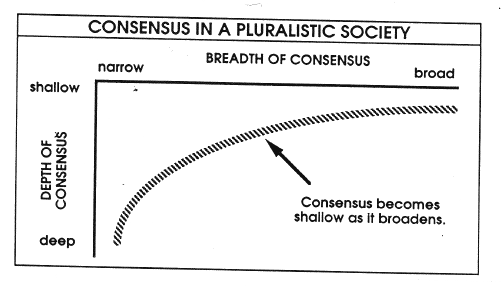
Figure 2
The Basic Coalitions
Variations in these attitudes define the eleven groups of the American electorate identified in the Times-Mirror report (1987, 1995). A brief synopsis of the groups identified in the Gallup poll is shown in Figure 3.
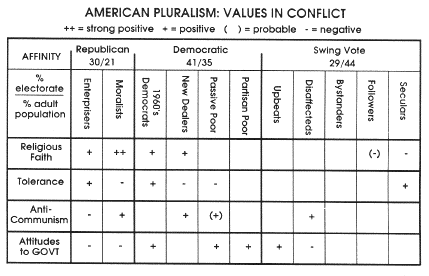
Figure 3
Politics and schooling are intimately connected in America. We can expect that members of these different groups will have different expectations for schools. For example, some values that directly generate controversies about the schools are religious faith, tolerance, anticommunism, and the role of government in society.
- Religious faith controversies raise the questions of prayer in the schools, the direct teaching of values, censorship, and sex education.
- Tolerance issues are found in disputes over bilingual education, student dress codes, and integration.
- Militant anticommunism articulates itself in questions about the nature of social studies education and the place of American history in the curriculum.
- Role of government issues are raised because federal funding for schools makes them subject to federal directives regarding discrimination. Figure 4 shows the relationship between the value discriminants and the groupings.
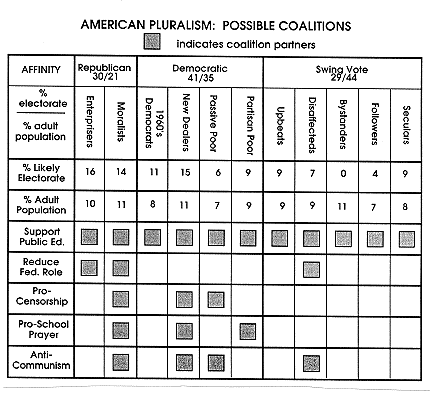
Figure 4
An Example of Diminishing Consensus
A later survey conducted by the Gallup Organization demonstrates how breadth of consensus shrinks as depth increases.[8] Respondents were asked if they thought that improving the quality of public education was a problem. Also, they were asked if they thought government action was required and if taxes should be raised to deal with it. We can identify a consensus of increasing depth but decreasing breadth:
- Issue A: The quality of public education should be improved; consensus -- 93 percent;
- Issue B: The quality of public education should be improved by government action; consensus -- 73 percent;
- Issue C: The quality of public education should be improved by government action and new taxes; consensus -- 47 percent.
Figure 5 illustrates these relationships.
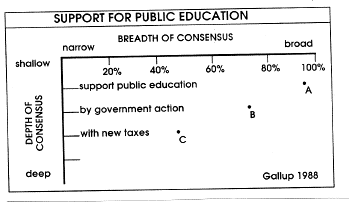
Figure 5
Coalitions of Support and Division
The fact is that there are no consistent pro or con choices on the issues of social justice, the federal role in schooling, censorship, school prayer, and anticommunism. The Times Mirror study points out that the terms "liberal" and "conservative" do not serve well in attempting to understand the relationship between politics and education. They are catchall words that obscure important differences among people. Figure 6 indicates that optimal "liberal" and "conservative" coalitions do not exist.
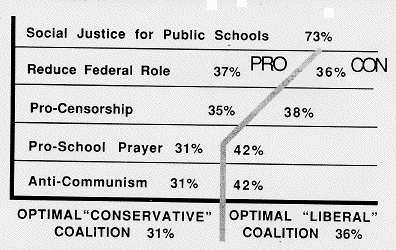
Figure 6
(Despite a resurgence of an apparently conservative coalition during the late 1990's and early 2000's deeper dissensions, e.g. on the role of religion in public life and on a reduced federal role, finally surfaced during the George W. Bush administration that reinstate our conclusion that optimal coalitions of liberals and conservatives do not exist.)
The Model
We can sort out these complex realities by putting them into a simple framework. All of the complexities are generated by the interaction of four simple factors:
- Expectations: What do people expect to be done?
- Consensus: What can they agree to get done?
- Tasks: How can they go about it?
- Resources: What is available to do the job?
It is the interaction of these factors as shown in figure 7 that illustrates the basic dynamics of the politics of schooling in America.
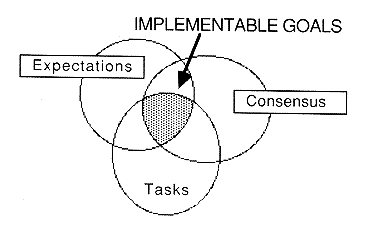
Figure 7
Expectations and Tasks
Actual goals are discovered only when the public goal is factored into operational goals -- those for which specific operations can be discovered. Once this is done, it turns out that there are several goals involved, and maximizing one will usually be at the expense of another. -- Charles Perrow[9]
Complex Organizations
The expectations for American schools will reflect substantially the values identified as important by the Times Mirror survey. Only as there is a consensus on expectations can schooling have clear public goals .[10] But actual goals, as Perrow calls them, also require depth of consensus. Why? Because public goals, to be implemented, have to be transformed into specific tasks. Educational goals are implementable only if tasks can be derived from them. Implementable public goals must always translate into nonconflicting tasks.
Tasks, too, may require a consensual process. The depth of consensus on a goal can affect what tasks are viable implementations of it. For example, instruction in art education may enjoy considerable support. But using live nude models may reduce such consensus to nonviability.
Consensus may not be uniform over all items, but may involve tradeoffs when one group requests an expectation to be broadly supported and then, in turn, supports another group's expectation. Such coalitions provide depth of consensus for items that would otherwise not be seen as connected, but that consensus is only as stable as the coalitions that support it.
Resources
Feasible tasks require resources. But resources may be subject to consensual processes which make specific tasks difficult to sustain. Certain resources require a consensual process for their availability. Examples of these consensual resources are taxes, tuitions, and contributions. Nonconsensual resources include things like endowments, reserve funds, or earnings. The stability of the consensus affects the continued availability of consensual resources. Politically unacceptable tasks can affect the resources needed for their completion.
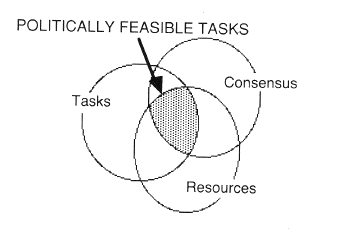
Figure 8
We have seen that the more specific the task is, the less likely is the breadth of consensus for the needed resources. This encourages appeals to nonconsensual authorities, e.g., the courts or commissions, to maintain resource levels where consensus is lacking. Similarly, where consensus falters, previously conceded expertise may be challenged through litigation.[11]
A major complication is that the consensual process that selects the expectations may not be the same one that identifies the relevant tasks nor the one which supports the allocation of resources. This means that in order to convert political rhetoric into reality, there must be simultaneous consensus on expectations, operational tasks, and allocation of resources. This is illustrated in the figure 9.
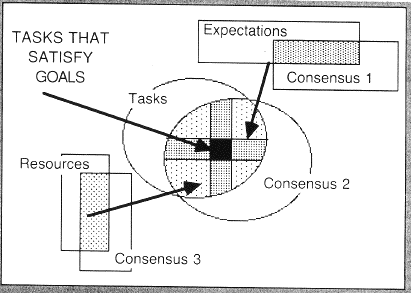
Figure 9
In addition, the life span of each of the four factors must be considered. Will any of the consensuses disappear before others? Will expectations change? Will the task outlive the resources? Suppose, for example, that implementing meaningful educational reform takes a minimum of 12 years. What politician would want to address the expectations of the electorate over that long a period of time? And what consensus would hold together long enough to get the job done?
|
To understand better how consensus and
commitment are critical issues, see
"The Indeterminacy of Consensus" |
Concerns and Responsibilities
The current political rhetoric on school reform is derived from a recent flood of educational reform reports. Most specifically, it reflects the pronouncements of "A Nation at Risk," the 1983 report by The National Commission on Excellence in Education. This report warned that America risks its ability to compete economically among other nations because of the poor quality of its schools. Indeed, the commission claimed, "If an unfriendly foreign power had attempted to impose on America the mediocre educational performance that exists today, we might well have viewed it as an act of war . . . . We have, in effect, been committing an act of unthinking, unilateral educational disarmament."[12]
In light of our foregoing analysis, we might ask the following questions:
- Is there a broad consensus that schools are responsible for our declining economic competitiveness?
- If so, is there deep consensus as to what educators are supposed to do about it?
- Has anyone talked about providing adequate resources?
The answer to all these questions is "No!" But one might object: Isn't $281 billion an adequate resource?
Two replies are possible:
1. Adequate resources are related ultimately to expectations. Perhaps for what is expected that figure is too low.
2. There are other resources besides money that are necessary to implement the tasks. They are generally ignored. Let's call them social resources. These are things like teacher and principal authority, parental support, and student readiness, without which no task can meet expectations.
Who is Responsible for What?
Contrary to the central assumptions of "A Nation At Risk," America's balance of trade problems may have little to do with the education of the American labor force. The following considerations certainly indicate a more plausible hypothesis.
International differences in labor productivity, or output per person per hour, do not have as much to do with the knowledge or work habits of the work force as they do the quantity and quality of the equipment workers use. Outdated and inefficient machinery needs to be replaced by investment. And the U.S. rate of investment is less than half that of Japan. Many economists argue that it is these low rates of investment in the U.S. that have led to uncompetitive productivity figures compared to other nations. Improvements in manufacturing productivity in output per hour from 1974?84 were: Japan 7.3 percent, West Germany 3.3 percent, Sweden 2.9 percent, U.K. 2.3 percent, and U.S. 2 percent.[13]
Investments are another related consideration. Economists point out that which nation invests the most has a great deal to do with international competitiveness. For the last four decades, Japan has been investing at a rate of about 20 percent of its GNP. Net investments in the U.S. have averaged less than half that since 1950.[14]
Another factor is poor labor/management relations. American management resists codetermination practices of proven productivity commonly used in Europe. Greater involvement of employees in decision making, similar to what the Japanese and Germans do, could help.
The distribution of benefits is still another factor. Employee motivation depends on how well economic benefits are distributed. If profit sharing is reduced while managers award themselves huge bonuses, employees reasonably conclude that hard work does not pay off.
The value of the dollar is also a major factor in the international competitiveness of American goods. A strong dollar makes imports cheaper, affecting our balance of trade unfavorably. It also drives up the price of American exports, depressing sales. The high value of the dollar also means that U.S. workers are paid more than their foreign counterparts. The value of the dollar rose steadily through the first half of the 1980s. In the last several years that trend has been reversed.
We can conclude that the claim that failures of America's schools are major factors in the decline of our international competitiveness is spurious, at best. Why then do many find it politically expedient to blame education for the nation's economic problems? There are a variety of reasons, no doubt. However, the following facts suggest a ready explanation:
- In 1984, senators in closely contested races spent an average of $6.5 million on their campaigns.
- A 1980 survey showed that less than seven percent of the population contributed directly to political campaigns.[15]
- Clearly, there are some big political donors. Does anyone imagine they are educators?
Reconsiderations
We said at the beginning that realities are complex and talk is cheap. But talk is cheap only for those who do not have to pay the costs of easy political rhetoric haphazardly implemented. Educators suffer the tensions of conflicting expectations. They face the frustrations of implementation procedures that are seldom highly effective. And suffering insult upon injury, they are offered resources so sparse as to suggest a serious belief in magic.
But there are others for whom talk is not cheap. They are parents and children who are led to expect so much, perhaps too much, from schools begrudgingly supported in their tasks. Their dreams wither, ultimately unsustained by those sloganizers who enjoy the fruits of elective office while avoiding its responsibilities.
[1] Daniel Bell, The Coming of Post?Industrial Society (New York: Basic Books, 1973).
[2] National Commission on Excellence in Education, A Nation at Risk: The Imperative for Educational Reform (Washington, DC: U.S. Department of Education, 1983), p. 7.
[3] The total bill for all college and university education came to $109 billion in 1987. About half of those dollars were raised by taxes. Students paid only 1/3 of the total via fees and tuition. The remainder came from endowments and contributions.
[4] If the $210 billion spent for training by corporations is added, total 1987 expenditures on all types of formal education neared the half trillion dollar mark.
[5] Arthur Applegate, et al., "Learning to Be Literate in America," The National Assessment of Educational Progress, The Nation's Report Card (Princeton, NJ: Educational Testing Service, 1987)
[6] "The People. Press & Politics," survey report for Times Mirror Corporation (September 1987), p. 4.
[7] Compare Debra Viadero, "Debate Intensifies Over School?Based Health Clinics," Education Week, 15 October 1986, p. 9.
[8] Margaret Petrella of the Gallup Organization, private correspondence with author, for Times Mirror Corporation, field dates 13 May 22 May 1985.
[9] Charles Perrow, Complex Organizations (Oakland, NJ: Scott?Foresman, 1979), p. 58.
[10] John Goodlad in Chapter 2 of A Place Called School (New York: McGraw-Hill, 1984) dodges the consensus problem by choosing goals from a literature search.
[11] Compare Stephen Goode, "Nation's schools courting trouble," INSIGHT (11July88): 56 - 57.
[12] National Commission on Excellence in Education, "A Nation at Risk: The Imperative for Educational Reform."
[13] Department of Labor, International Comparisons of Manufacturing Productivity and Labor Cost Trends, Preliminary Measures for 1984, revised tables, news release, p. 2, Table A (10 June 1985).
[14] Data for 1951?80: Organisation for Economic Cooperation an Development (OECD) National Accounts, vol 1, 1951?80, ed. 1982, pp. 30, 32, 48, 68, 74. Data for 1981?84: United Nations, National Accounts Statistics: Main Aggregates and Detailed Tables, pp. 563, 835, 1602. 1649, 1984.